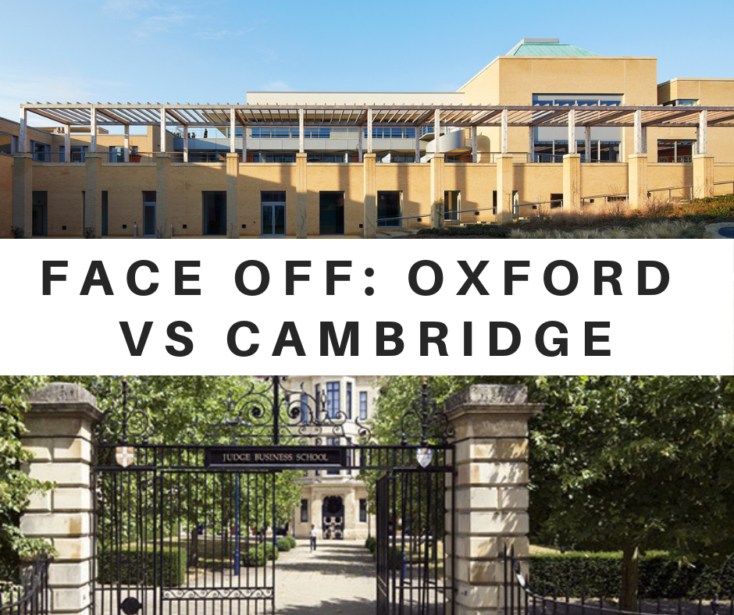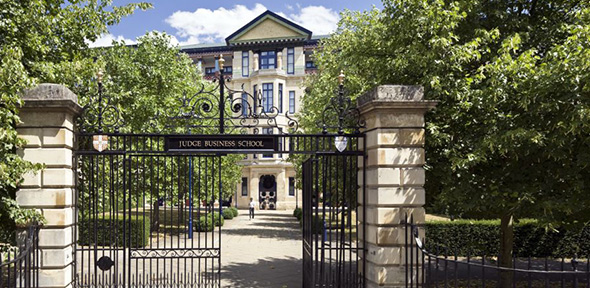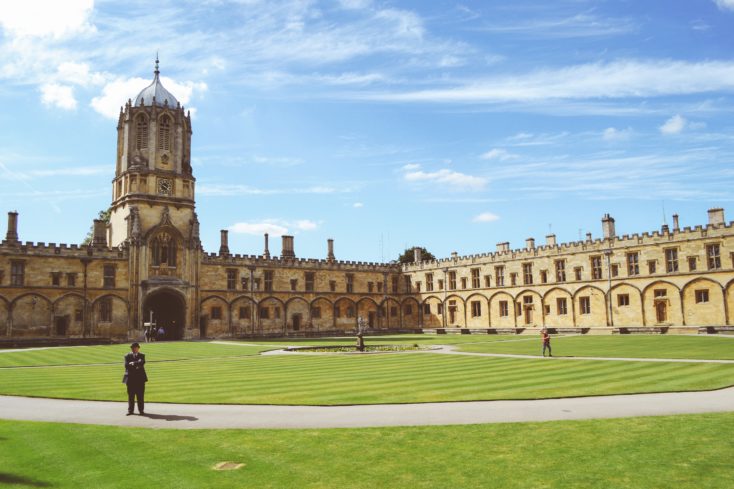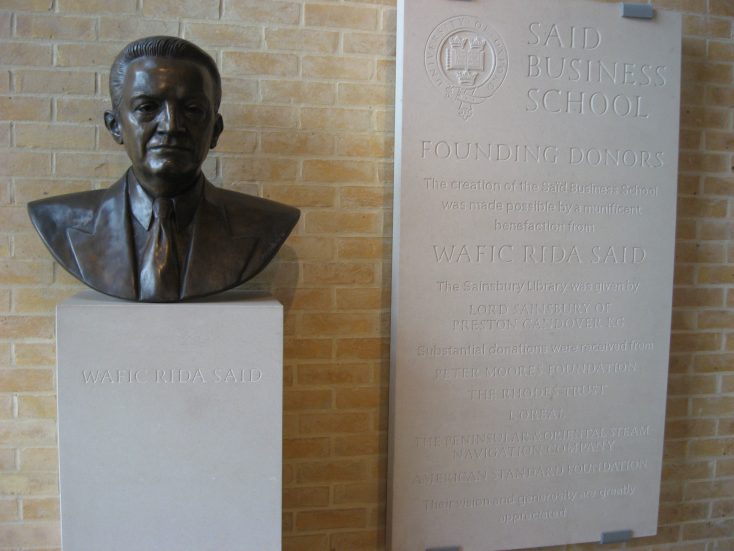-
Target Test Prep 20% Off Flash Sale is on! Code: FLASH20
Redeem
Face Off: Oxford vs. Cambridge
 The school selection process for MBA applicants can seem overwhelming. With so many great business schools, how do you decide which one is right for you? In SBC’s blog series Face Off, we tease out the strengths and differences between two similarly ranked, or located, b-schools. Plus, we’ll highlight noteworthy elements of their admissions processes. Let’s kick things off by looking at the differences between the Oxford MBA application versus that of University of Cambridge Judge School of Business.
The school selection process for MBA applicants can seem overwhelming. With so many great business schools, how do you decide which one is right for you? In SBC’s blog series Face Off, we tease out the strengths and differences between two similarly ranked, or located, b-schools. Plus, we’ll highlight noteworthy elements of their admissions processes. Let’s kick things off by looking at the differences between the Oxford MBA application versus that of University of Cambridge Judge School of Business.
How do the admissions requirements and selectivity compare between the Oxford MBA application and Cambridge Judge?
- Both schools have similar admissions requirements.
- Both require a good undergraduate degree. Cambridge mentions that they prefer candidates to be in the top 25% of their undergraduate graduating class.
- Both accept the GMAT and GRE and one is a requirement. The average GMAT at Cambridge is 693 and the median GMAT at Oxford is 690. Neither reports GRE score averages. Neither reports GMAT score minimum requirements. However, the admissions team recommends that applicants aim for a score of 650 or above.
- Oxford requires a minimum of two years’ experience before the MBA, whereas Cambridge requires three years’ pre-MBA experience.
- Cambridge requires one professional reference. Oxford asks for two references, with at least one being professional.
- Both have a 110 TOEFL or 7.5 IELTS requirements for those who require an English test.
- Cambridge has three required essays, whereas Oxford only has one compulsory essay and one optional essay.
- Cambridge strongly prefers selected applicants to interview on campus. However, they do offer regional and Skype interviews. Oxford has no preference as to whether applicants attend an in-person interview, and offers many regional interview days and Skype interview opportunities.
Oxford enrolls 100 MBA students more each year than Cambridge. However, Oxford does receive considerably more applications. Recent releases show Oxford had 1,586 applications for the Class of 2019, and Cambridge had 1,286. The schools do not release their acceptance rate. However, on a ratio of application to in class, Cambridge has a slightly lower acceptance rate than Oxford. 
What are the key differences between Oxford and Cambridge that an MBA applicant must consider?
One of the biggest challenges faced by applicants considering applying for an MBA at Cambridge Judge and Oxford Said is the number of similarities the schools have on paper:
- Both schools offer a one-year MBA program starting in September.
- Both business schools are embedded in very famous and prestigious universities with excellent reputations globally.
- One of the defining features of the Oxford and Cambridge MBA programs are the collegial systems in place at both universities. Students at both Said and Judge are also members of one of their respective university’s colleges.
- Colleges are academic communities within the universities. Colleges select which students they admit. Students can live, eat and socialize in their college. Colleges have their own unique identities and traditions. Students are admitted to the MBA program first and then the business school helps them applying for a college space. Each student studying an MBA at Oxford or Cambridge must be a member of a college.
- The University of Oxford is made up of 44 colleges and halls. The University of Cambridge has 31 colleges.
- Both MBA programs offer an internship option in the final summer semester.
Although there are many similarities between the two schools, the MBA programs and student experience are different.
The key differences are:
- Class size: The Oxford MBA typically enrolls between 315 and 330 students a year. Meanwhile, the Cambridge MBA enrolls between 200 and 210 students a year.
- Cost: The Oxford MBA has a tuition cost of £57,200 for next intake, while the Cambridge MBA has a tuition fee of £55,000.
- Curriculum: Both programs offer compulsory core subjects but also give students options to choose electives from a wide portfolio. Cambridge offers the opportunity to have a specialization, whereas Oxford does not offer specializations.
- Oxford has a strong ethos of responsible business and leadership within the campus and the MBA program. This is seen through themes, co-curricular activities, and subjects in the program.
How do the two schools’ locations compare, and what impact will this have on the student experience and/or job opportunities?

- Both Oxford Said and Cambridge Judge are easily accessible from London, with both located about an hour from London by train.
- Cambridge is about 50 minutes by train from central London, from Kings Cross Station. From the train station, it is a 7-minute drive to the Judge Business School campus.
- The city of Oxford is an hour on the train from central London. Trains to Oxford run from both Marylebone station and Paddington Station. The Said Business School is right next door to the train station.
- Both Oxford and Cambridge are smaller cities.
- In terms of student experience, students from both campuses spend quite a bit of time in their respective cities and networking with the student communities in their business school and the wider university.
- Both Cambridge and Oxford are busy and historic university towns. The University of Oxford has just under 24,000 students enrolled (as of 2017 data), whereas the University of Cambridge has about 21,500 students enrolled. Oxford also has another university, which adds to the student atmosphere in the city.
How does this impact job opportunities?
- Both schools have strong brands and reputations and are therefore able to attract employers based in London and globally to visit campus for networking and recruiting events. The schools' career teams also do a lot of outreach to companies. The schools work with students to offer career treks to key employers and locations around the globe.
- A small number of students who launch their own business will remain in Cambridge or Oxford to benefit from the spin out opportunities in the respective universities. Most students do not remain in Oxford or Cambridge after graduation.
How do the two schools’ MBA cohorts compare in terms of quality and culture?
- Cambridge and Oxford tend to have a similar applicant pool. Many are attracted by how interconnected the business schools are to the parent university and the college system. The college systems at Oxford and Cambridge are a strong selling point for both schools due to the networking opportunities and diverse experience that this provides.
- Both schools have seen a consistent increase in applications over the last few years. The Oxford class has grown from roughly 220 students to over 300 about three years ago. Cambridge’s class has not grown as much over the last number of years.
- The larger class at Oxford has led to the opportunities to build wider networks with a more diverse class. They have grown the student support services and career services to meet the demands of a larger cohort. However, Cambridge students do enjoy the smaller and more intimate class size.
- Class size: Oxford has 315 students this year and Cambridge has 206 students for the class of 2018-19.
- At a high level, Oxford does somewhat better with female enrollment, at 39% compared to Cambridge’s 36%. Oxford also has a wider representation of nationalities, which may be a natural result of their larger class (109 more students than Cambridge).
- In terms of diversity, Oxford takes considerably more students from North America than Cambridge, with 26% of the Oxford MBA hailing from North America, compared to 21% of Cambridge’s class. Oxford does a lot better with African students, at 11% compared to Cambridge’s 5%.
- Cambridge has 23% of their students from East Asia and South East Asia, whereas Oxford comes in at 18% for these regions.
- Cambridge attracts 10% of their MBA students from Latin America, compared to Oxford’s 5%.
- With European students, both schools attract about the same percentages.
Cambridge Judge
[caption id="attachment_35534" align="aligncenter" width="734"] Cambridge, England[/caption]
Cambridge, England[/caption]
- Cambridge’s class of 206 students has 51 different nationalities represented, with an average of 6 years’ experience; 36% of the class are female, and the average GMAT score is 693.
- Looking at the background of students; 25% come from finance, 24% from consulting, 46% from industry and 5% from NGO / Not-for-Profit / Public Sector / Research / Education.
Oxford Said
[caption id="attachment_35535" align="aligncenter" width="734"] Oxford, England[/caption]
Oxford, England[/caption]
- Oxford’s MBA class of 315 students has 62 different nationalities represented, with an average experience of 5 years; 39% of the class are female and the median GMAT is 690.
- Oxford does not offer information on the industry breakdown of their intake.
- However, they tend to attract about 25% of their class from finance, 20% from consulting, 10% from social impact/NGO and 45% from industry, with a strong technology representation.
- Both schools highlight the interactive nature of their classes, the diverse students on the program, opportunities to engage and network with the wider university community, and academic rigor.
- Both schools have very international and diverse classrooms. This diversity leads to lively discussions, challenging group projects and more extensive global networks.
- Neither school has one dominant pre-MBA industry. Students are encouraged, and required, to work with students from all industries and nationalities through group projects.

How do the two curricula and teaching methods compare?
- Both schools split the academic year into semesters (three teaching semesters and summer semester).
- The schools have a mixture of compulsory core courses, mandatory projects, and a range of elective courses to choose from.
- Oxford offers between 30 and 40 elective choices, while Cambridge offers between 40 and 50 electives.
- Oxford does not offer a specialization, whereas the Cambridge MBA allows students to have a specialization in one of the follow areas: Culture, Arts & Media Management, Digital Transformation, Energy & Environment, Entrepreneurship, Finance, Global Business, Healthcare Strategies, Marketing, Social Innovation or Strategy.
- Although Oxford doesn’t offer specializations, it does have a number of cross-cutting themes included in their curriculum: The Global Rules of the Game, Entrepreneurship and Responsible Business
- Cambridge has three required team projects that engage with external companies or organizations: one focused on consulting, one on marketing analysis, and one focused on their concentration.
- Oxford has two required team projects: one in entrepreneurship and one focused on a global threat or opportunity.
- Both schools have a variety of teaching and learning methods. This includes lectures, team projects, workshops, seminars, individual projects and class participation.
- Both programs offer the option for a summer internship from June-August. Students can also take part in an individual project, and students at Oxford can take extra electives in the Summer term. Meanwhile, Cambridge students can opt for a research paper or dissertation.
- Oxford offers optional co-curricular courses for MBA students in consulting, finance and social impact: The Finance Lab, Consulting Development Programme and Social Impact Lab. These give students the opportunity to gain additional exposure and practical experience for students looking to return to or transition into these areas.
How do the career outcomes between the schools stack up?
- Both schools have reported strong career outcomes in recent years. For the class graduating in 2018, Cambridge reported that 92% of the graduates had a job offer three months after graduation, with 85% of them employed. Oxford reports that 91% of graduate seeking employment have accepted an offer within three months of graduation.
- At Oxford 29.4% end up in finance, 21.6% are in consulting, 9.8% in social impact and 20.6% in technology.
- At Cambridge, 19% of those employed were in consulting and 25% in finance. Technology is the largest employment sector for the remainder of the graduates.
- 42% of those employed from the Cambridge class remained in the UK, 11% in the remainder of Western Europe and 16% in north America. 11% are in East Asia and 9% in Southeast Asia.
- Oxford list 57% in European Free Trade countries, 17% in north America and 16% in Asia.
- In terms of salaries for Cambridge graduates, the average for those in Europe is £71,682 and for those in North America it is £90,519. At Oxford the average in Europe (excluding the UK) is £71,094 and the average in North America is £87,175.
*** We hope this deep-dive comparison between the Oxford MBA application and MBA experience versus Cambridge Judge has given you helpful intel as you make your school selection decisions this season. Finally, please leave any questions you may still have in the comment section below.
Recent Articles
Archive
- April 2024
- March 2024
- February 2024
- January 2024
- December 2023
- November 2023
- October 2023
- September 2023
- July 2023
- June 2023
- May 2023
- April 2023
- March 2023
- February 2023
- January 2023
- December 2022
- November 2022
- October 2022
- September 2022
- August 2022
- July 2022
- June 2022
- May 2022
- April 2022
- March 2022
- February 2022
- January 2022
- December 2021
- November 2021
- October 2021
- September 2021
- August 2021
- July 2021
- June 2021
- May 2021
- April 2021
- March 2021
- February 2021
- January 2021
- December 2020
- November 2020
- October 2020
- September 2020
- August 2020
- July 2020
- June 2020
- May 2020
- April 2020
- March 2020
- February 2020
- January 2020
- December 2019
- November 2019
- October 2019
- September 2019
- August 2019
- July 2019
- June 2019
- May 2019
- April 2019
- March 2019
- February 2019
- January 2019
- December 2018
- November 2018
- October 2018
- September 2018
- August 2018
- July 2018
- June 2018
- May 2018
- April 2018
- March 2018
- February 2018
- January 2018
- December 2017
- November 2017
- October 2017
- September 2017
- August 2017
- July 2017
- June 2017
- May 2017
- April 2017
- March 2017
- February 2017
- January 2017
- December 2016
- November 2016
- October 2016
- September 2016
- August 2016
- July 2016
- June 2016
- May 2016
- April 2016
- March 2016
- February 2016
- January 2016
- December 2015
- November 2015
- October 2015
- September 2015
- August 2015
- July 2015
- June 2015
- May 2015
- April 2015
- March 2015
- February 2015
- January 2015
- December 2014
- November 2014
- October 2014
- September 2014
- August 2014
- July 2014
- June 2014
- May 2014
- April 2014
- March 2014
- February 2014
- January 2014
- December 2013
- November 2013
- October 2013
- September 2013
- August 2013
- July 2013
- June 2013
- May 2013
- April 2013
- March 2013
- February 2013
- January 2013
- December 2012
- November 2012
- October 2012
- September 2012
- August 2012
- July 2012
- June 2012
- May 2012
- April 2012
- March 2012
- February 2012
- January 2012
- December 2011
- November 2011
- October 2011
- September 2011
- August 2011
- July 2011
- June 2011
- May 2011
- April 2011
- March 2011
- February 2011
- January 2011
- December 2010
- November 2010
- October 2010
- September 2010
- August 2010
- July 2010
- June 2010
- May 2010
- April 2010
- March 2010
- February 2010
- January 2010
- December 2009
- November 2009
- October 2009
- September 2009
- August 2009